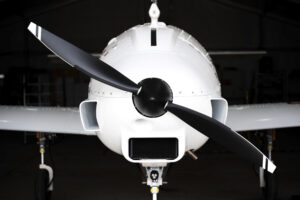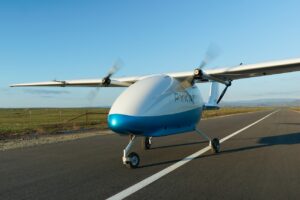In the area of medium-range cargo delivery, heavy-lift cargo drones are being developed which look set to be amongst the first large-scale applications of autonomous flight technology.
“Middle-mile delivery is what everyone is betting on, and which seems to be most realistic,” says Nils Shaefer, a research analyst at consultants Frost and Sullivan, which recently authored a report on the nascent heavy-lift drone market.
“The market is at a turning point right now,” says Shaefer. “Many companies that are developing heavy-lift cargo drones have a large backlog of orders, and they are just starting to manufacture, with most companies expecting to begin deliveries either next year or in 2026.”
Companies interested in the new technology include postal companies like Greece’s Hellenic Post, which recently signed an agreement with the European drone developer Dronamics to begin middle-mile parcel deliveries between the Greek mainland and islands.
Meanwhile, the UK’s Royal Mail has partnered with the drone services company Skyports on a pilot project using a heavy-lift Pyka cargo drone in the southwest of England.
Elsewhere, the Danish renewables company Ørsted has been conducting trials using a heavy-lift robotic drone to supply cargo to offshore wind turbines. While in North America, the Canadian government last year signed a contract with Drone Delivery Canada to use its heavy-lift aircraft for mining, oil and gas inspections, and emergency preparedness. As Dronamics co-founder and chief technology officer Konstantin Rangelov puts it: “There is no major reason that should prevent the automation and droneifcation of cargo aircraft.”
Cutting costs
Heavy-lift drones are being considered because they lower costs, believes Shaefer. “It lowers manufacturing and operations costs,” he says.
“Taking humans out of the equation significantly reduces operational costs,” says Rangelov. “You don’t have a flight crew that’s traveling between destinations that requires accommodation.”
Moreover, the aircraft can be more cost-efficient without life support systems, a temperature-controlled environment and a pressurized cabin. “That saves a lot of development and manufacturing time,” says Rangelov.
The growing interest in heavy-lift drones is also a consequence of the regulatory landscape around drones. One of the reasons that plans for drone parcel delivery have so far come to nothing is because of the stringent rules governing airspace. Both the FAA and EASA have moved slowly on allowing beyond visual line of sight (BVLOS) unmanned flight, particularly in populated urban areas.
However, flights to and from remote island communities present far less of a problem for regulators. Several leading drone developers have recognized that regulators are more forgiving in less populated regions. In addition, they understand that for these kinds of cargo operations a heavy-lift drone makes far more sense logistically than a small-sized drone.
In the long run automated heavy-lift aircraft will also prove a better option than manned aircraft of an equivalent size, believes Michael Merritt, commercial and growth lead at Skyports. He says, “It is what the market is asking for. With drones, you can have an offering which is a similar price per kilogram to that of a Cessna Caravan but you can do it entirely automated.
“Drones are going towards offering the same services as small aircraft.”
The right size

Dronamics began developing their larger cargo drone in 2014. Rangelov, who founded the company with his brother Svilen, who serves as Dronamics’ CEO, said that they realized early on that the kind of last-mile drone delivery being trumpeted by Bezos would be much harder to realize, especially in their native Bulgaria, where many people live in apartment blocks with multiple floors.
As they searched for the right size of aircraft, they considered making a drone equivalent in dimensions to a commercial jet like a Boeing 737 or an Airbus A320. However, Rangelov says they soon rejected this idea after realizing they would need large airports and would not be able to access rural areas.
Aiming their sights at an aircraft dimension in between a quadcopter and an A320, they decided on something roughly the size of a Cessna. When defining the exact dimensions, they came upon a simple but elegant solution.
“We have made it big enough to transport as much cargo as fits in a delivery van,” says Rangelov. “So that we could seamlessly integrate it into the existing network infrastructure for deliveries.”
Once they had agreed on the aircraft’s size, Rangelov and Sylien began the nine-year process of designing and developing the aircraft. In terms of the design, Rangelov initially considered basing it on Textron’s popular Cessna Caravan. However, it soon became clear that there were too many differences in the design requirements to make that feasible.
“A Cessna is designed to have people on board,” says Rangelov. “So even though it might carry a similar payload it doesn’t have the interior volume necessary for parcels. For the parcels to be accommodated, the internal volume of the aircraft needs to be much bigger.”
In the end, they opted for a clean-sheet design. The Black Swan is a remote-piloted fixed-wing drone capable of carrying 350kg (770 lbs) of cargo, equivalent to a small delivery van, and with a wingspan of 16m (52ft) and a range of 2,400km (1,500 miles).
Pyka’s Pelican

With a payload capacity of 180kg (400lbs) and a wingspan of 11.5m (38ft), Pyka’s cargo drone, Pelican Cargo, is somewhat smaller than the Black Swan and has a much shorter range of 320km (200 miles). The smaller scale of the Pelican is largely a result of its all-electric design, and the weight and range limitations imposed by battery-powered flight. The Black Swan will initially be powered by SAF.
The Pelican Cargo’s design is based on Pyka’s first fixed-wing drone, which was built for crop-spraying operations in the agricultural industry. Known as the Pelican Spray, the drone is already in use in Central and South America, and last year received FAA approval to be used in crop protection operations throughout the US.
According to Pyka’s chief commercial officer Volker Fabian, the company had considered developing a cargo drone before deciding on the crop-spraying aircraft.
“We thought about autonomous electric cargo missions, but we didn’t believe the hype around eVTOLs and thought that time frames to market including regulatory approvals were unrealistic,” Fabian says.
After re-activating conversations with e-commerce platforms around cargo drones, Pyka discovered that the dimensions of the Pelican were more in line with what they were looking for.
Fabian says, “Customers were asking if they could take the spray tank out and put boxes in. The conversion is not quite that easy to accomplish. But those customer’s interest brought us to analyzing the market, identifying the need and designing Pelican Cargo so that it has high commonality and ease of manufacturing with the Pelican Spray.”
The Pelican Cargo was launched in January 2023 and has several key differences to the Pelican Spray. The Pelican Cargo’s batteries are inside the nose cone for instance, so that they can be quickly swapped for recharged ones. However, research revealed that users loved the Boeing 747’s nose-loader configuration. The Pelican design was modified to accommodate nose-loading and the battery moved to below the fuselage, which was also enlarged to create more volume capacity for cargo. Through a commercial partnership with Skyports, Pyka is hoping to expand the market for its aircraft, but it will require a certain amount of educational outreach to help logistics industry stakeholders and other potential users understand the benefits offered by the cargo drone.
“Unlike the Pelican Spray, it’s not a direct replacement for an existing aircraft,” he says. “Therefore, it takes a little time to show customers the flexibility and the capabilities of the aircraft. And that is where we are at right now.”
Source link

